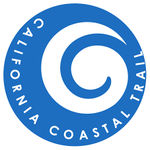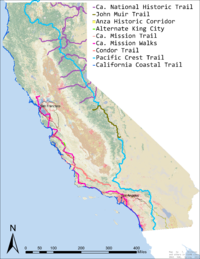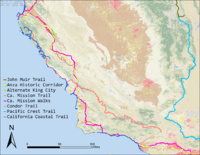California Coastal Trail (CCT)
Contents
Summary
The California Coastal Trail (CCT) is a large-scale public project led by the California Coastal Conservancy (CCC) [1]. Their goal is to create a network of public trails along the California coast for walkers, bikers, equestrians, wheelchair riders, and others - separated from direct risks associated with automobile traffic. Designed to be one continuous trail, the coastline is broken up by private land.
Today roughly 60% of the CCT is complete. The Conservancy works to complete the trail while working with other state agencies, including the Coastal Commission and State Parks, to coordinate the development of the CCT [2].
History
Records of individuals hiking the entirety of the California Coastline goes back as far as 1911 [3]. The dream of connecting the coastline in one uninterrupted trail for the public took its first steps in 1972 when Proposition 20 was passed by Californian Legislators. Proposition 20 stated the desire to build “a hiking, bicycle, and equestrian trails system shall be established along or near the coast” and that “ideally the trails system should be continuous and located near the shoreline.” [4]
Proposition 20 "Creates State Coastal Zone Conservation Commission and six regional commissions." Prop 20 created criteria for "preservation, protection, restoration, and enhancement of environment and ecology of the coastal zone" and required the submission other these plans to legislatures. Prop 20 also defined coastal zone (where the CCT would exist) as "the area between the seaward limits of state jurisdiction and 1000 yards landward from the mean high tide line, subject to specified exceptions." It will be within this designated area the CCT would be created. Any further construction unassociated with the CCT would require permits for approval. This reservation of coastal land for the CCT did not work retroactively. Privately owned land would not be taken from the private owners unless donated or purchased.[5]
Proposition 20 was originally funded for three years. It was made permanent with the passing of the California Coastal Act. The Coastal Act was a landmark law for environmental justice and the California Coastal Trail. It stated that "lands between the first public road and the sea; sale or transfer(a) Except as provided in subdivisions (b) and (c), no state land that is located between the first public road and the sea, with an existing or potential public accessway to or from the sea, or that the commission has formally designated as part of the California Coastal Trail, shall be transferred or sold by the state to any private entity unless the state retains a permanent property interest in the land adequate to provide public access to or along the sea." The Californa Coastal Act solidified the CCT's presence and offered the opportunity for funding and the long-term presence for the public. [6]
The California Coastal Trail was awarded the Federal Millennium Legacy Trail (FMLT) designation in 1999.[7] A Federal Millennium Legacy Trail designation is designed to "recognize, promote and stimulate the creation of trails.[8].
California Legislators passed SB 908 in 2001 that required the conservancy and development of the California Coastal Trail. It requires the consultation of the State Parks, the California Coastal Commission, and the coordination of their respective departments with planning and preparing available lands for the CCT.[9]
In June 2003, a group of hikers, CTE '03, aimed to hike the 1200-mile coastline of California. They recorded their experiences, the sites that required significant inland detours, sites inaccessible due to private land, and areas along dangerous highways. Nine of the hikers made it to Mexico after 112 days of hiking along the trail, with minimal assistance. The tenth member of their group had to drop out of the hike after an accident left them with a broken leg. 700 miles of the CCT had established trails. 500 miles failed to meet the requirements established by the California Coastal Act of 1976 and SB 908 in 2001.[10]
Goal
A continuous, unbroken, braided trail for "hiking, bicycle, and equestrian" use stays near the shoreline (within sight/hearing/smell). These interconnecting trails and routes across the entirety of the California Coastline will be open for public use at all times for the protection of sensitive coastal ecosystems, the enjoyment of the public, and the benefit of coastal communities and businesses. [11]
The "braided trails" will be include hiking paths, improved multi-use trails for bicyclists and mobility challenged users, and trails for light use around sensitive habitats. It will the accumulation of Rugged wilderness trails to paved paths.
Challanges
- Boundaries: The California Coastal Trail crosses multiple counties and districts as it runs through the entirety of California. This requires the California Coastal Conservancy to communicate and work with each department. Each county and/or district has unique requirements that the CCC must navigate in its efforts to link each branch of the CCT together.
- Private land: The California Coastal Act of 1976 could not act retroactively to reserve land for the California Coastal Trail. Previously owned land within the area designated by the California Coastal Act was retained by their respective owners. The California Coastal Conservancy works with local and other non-profit groups to purchase or conduct negotiations with the owners to allow the public access to the CCT on their land.
- Climate Change: Climate change is continuing to offer a unique challenge to coastal communities and projects and is a topic of continual research. The greatest dangers lie in increased sea levels, extreme weather events, and erosion of both coastal and inland slopes.
California Coastal Trail in Central California
The Central California Area (CCA) is home to significant sites such as the Monterey Bay Aquarium, BigSur, beautiful state, and federally protected coastline. The California Coastal Trail continues through the CCA, impeded by private landowners, busy highways, and coastal communities. To CCT branches into the hills and ridges of BigSur, giving stunning panoramic views of California's coastline as it heads south towards San Luis Obispo.
The California Coastal Trail is included in the proposed area of the Range of the Condor National Heritage Area. The Range of the Condor NHA is a proposed area of 28 million acres for a National Heritage designation.
Links
- The Condor Trail
- California Coastal Conservancy
- Long distance trails in California's Central Coast Region
- Recreational Planning Initiatives in the California Central Coast
- CA Coastal Trail Project Website
References
- ↑ California Coastal Trail https://californiacoastaltrail.org/
- ↑ SCC Coastal Trail https://scc.ca.gov/projects/california-coastal-trail/
- ↑ CCT Whole Trail https://californiacoastaltrail.org/hikers-resources/whole-trail-hikers/
- ↑ CCT Hikers Resources https://californiacoastaltrail.org/hikers-resources/about-cct/
- ↑ Prop. 20 https://ballotpedia.org/California_Proposition_20,_Creation_of_the_California_Coastal_Commission_(1972)
- ↑ Coastal Act 1776 https://www.coastal.ca.gov/coastact.pdf
- ↑ FMLT 1999 designation https://coastwalk.org/wp-content/uploads/docs/cct/SIGNAGE%20GUIDELINES%20FINAL%20copy.pdf
- ↑ Millennium Trails https://clintonwhitehouse2.archives.gov/Initiatives/Millennium/trails.html
- ↑ SB 908http://www.leginfo.ca.gov/pub/01-02/bill/sen/sb_0901-0950/sb_908_bill_20011003_chaptered.html
- ↑ CTE ‘03 Hikers https://www.kcet.org/shows/california-coastal-trail/a-brief-history-of-the-california-coastal-trail
- ↑ CCT Trails https://coastwalk.org/california-coastal-trail-2/
Disclaimer
This page may contain student work completed as part of assigned coursework. It may not be accurate. It does not necessarily reflect the opinion or policy of CSUMB, its staff, or students.


